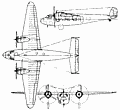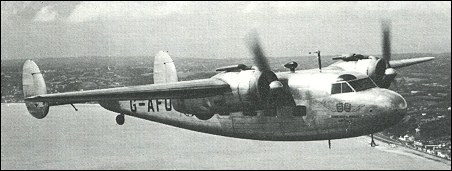|
| The company's first aircraft of all-metal
stressed-skin construction, the de
Havilland D.H.95 Flamingo was designed
by R. E. Bishop as a mediumrange
passenger transport to carry 12-17
passengers and a crew of three. It
featured hydraulically retractable landing
gear, split trailing-edge flaps and was
powered initially by two 664 kW (890hp)
Bristol Perseus XIIc radial engines. The
prototype was first flown by de Havilland
chief test pilot Geoffrey de Havilland Jr
at Hatfield on 28 December 1938; during
subsequent flight testing a third, central
fin was fitted temporarily. In May 1939
this aircraft was delivered to Guernsey &
Jersey Airways Ltd for route-proving
trials, linking Heston and Southampton's
Eastleigh Airport with the two principal
Channel Islands.
The outbreak of war precluded commercial
use on these services, but the
Royal Air Force had ordered two
Flamingoes for communications duties
with No. 24 Squadron and one for The
King's Flight, the last being delivered to
RAF Benson on 7 September 1940. It
was transferred to No. 24 Squadron in
February 1941, the unit having acquired
also the prototype, two aircraft ordered
by civilian customers and the fifth airframe
which had been used by the
manufacturer for development of the
Bristol Perseus XVI radial. This engine
was fitted to all subsequent examples,
including one used by the Royal Navy's
No. 782 Squadron at Donibristle for communications
flights to the Orkney and
Shetland Islands and to Northern Ireland,
and eight flown by BOAC on Middle East
services, based at Cairo. The Royal
Navy's Flamingo was the only aircraft to
return to civil use after the war, seeing
limited service with British Air Transport
at Redhill where it was scrapped in 1954.
Flamingo production totalled 16 aircraft.
 | A three-view drawing (700 x 639) |
| MODEL | D.H.95 |
| ENGINE | 2 x Bristol Perseus XVI radial piston engines, 694kW |
| WEIGHTS |
| Take-off weight | 7983 kg | 17600 lb |
| Empty weight | 5137 kg | 11325 lb |
| DIMENSIONS |
| Wingspan | 21.34 m | 70 ft 0 in |
| Length | 15.72 m | 52 ft 7 in |
| Height | 4.65 m | 15 ft 3 in |
| Wing area | 59.36 m2 | 638.95 sq ft |
| PERFORMANCE |
| Max. speed | 385 km/h | 239 mph |
| Cruise speed | 296 km/h | 184 mph |
| Ceiling | 6370 m | 20900 ft |
| Range | 1947 km | 1210 miles |
| croydon parry, e-mail, 08.04.2020 15:48 A number of sources mention that they were unpopular.
Also, a seemingly high number of crashes. Is that why ,and if so what were the causes ? reply | | jamie, 21.08.2011 18:44 There's a good photo of two Flamingos in RAF livery in Aug 2011 issue of FlyPast mag, reply | | chris stark, e-mail, 15.04.2011 11:30 A Flamingo aircraft is mentioned in winston Churchill's history of the Second World War, he used one for trips to France prior to that country's surrender.
He usually travelled with an escort of 12 Spitfires, and according to his book on one occasion they had to remain in France due to lack of fuel, leaving the Flamingo to return alone. Two German aircraft were spotted over the channel attacking fishing boats; had they seen the unarmed Flamingo then WC would hardly have survived the encounter. reply | | Chris Scott, e-mail, 27.07.2010 20:02 A BBC war correspondent noted a flight in one from Amiens to England Febuary 1940. See the book A.A.A.F. Charles Gardner page 81. He was very complimentary. reply | |
| | Matty, e-mail, 22.02.2010 22:06 I managed to track down and obtain some further information from the aircraft illustrated magazine dated November 1968... and there should be some more information in the october issue if anyone has it... I would be most appreciative to have the information in the issue if anyone has it :) reply | | Barry, 16.09.2009 15:19 Known in the R.A.F. as the Hertfordshire reply | | miltransuk@yahoo.co.uk, e-mail, 14.11.2006 04:27 FYI, have a photo of G-AFUE IN AUCTION ON eBAY reply |
|
Do you have any comments?
|
| 
COMPANY
PROFILE
All the World's Rotorcraft
|







